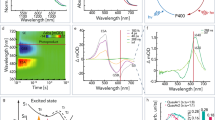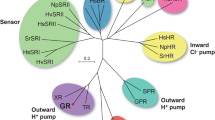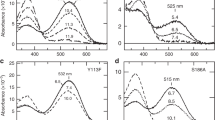Abstract
The microbial phototaxis receptor sensory rhodopsin II (NpSRII, also named phoborhodopsin) mediates the photophobic response of the haloarchaeon Natronomonas pharaonis1,2 by modulating the swimming behaviour of the bacterium3. After excitation by blue-green light NpSRII triggers, by means of a tightly bound transducer protein (NpHtrII), a signal transduction chain homologous with the two-component system of eubacterial chemotaxis4. Two molecules of NpSRII and two molecules of NpHtrII form a 2:2 complex in membranes as shown by electron paramagnetic resonance5 and X-ray structure analysis6. Here we present X-ray structures of the photocycle intermediates K and late M (M2) explaining the evolution of the signal in the receptor after retinal isomerization and the transfer of the signal to the transducer in the complex. The formation of late M has been correlated with the formation of the signalling state2,7. The observed structural rearrangements allow us to propose the following mechanism for the light-induced activation of the signalling complex. On excitation by light, retinal isomerization leads in the K state to a rearrangement of a water cluster that partly disconnects two helices of the receptor. In the transition to late M the changes in the hydrogen bond network proceed further. Thus, in late M state an altered tertiary structure establishes the signalling state of the receptor. The transducer responds to the activation of the receptor by a clockwise rotation of about 15° of helix TM2 and a displacement of this helix by 0.9 Å at the cytoplasmic surface.
This is a preview of subscription content, access via your institution
Access options
Subscribe to this journal
Receive 51 print issues and online access
$199.00 per year
only $3.90 per issue
Buy this article
- Purchase on Springer Link
- Instant access to full article PDF
Prices may be subject to local taxes which are calculated during checkout




Similar content being viewed by others
References
Spudich, J. L. Variations on a molecular switch—transport and sensory signalling by archaeal rhodopsins. Mol. Microbiol. 28, 1051–1058 (1998)
Klare, J. P. et al. The archaeal sensory rhodopsin II/transducer complex: a model for transmembrane signal transfer. FEBS Lett. 564, 219–224 (2004)
Scharf, B. E. & Wolff, E. K. Phototactic behaviour of the archaebacterial Natronobacterium pharaonis. FEBS Lett. 340, 114–116 (1994)
Rudolph, J. & Oesterhelt, D. Deletion analysis of the che operon in the archaeon Halobacterium salinarium. J. Mol. Biol. 258, 548–554 (1996)
Wegener, A. A., Klare, J. P., Engelhard, M. & Steinhoff, H.-J. Structural insights into the early steps of receptor–transducer signal transfer in archaeal phototaxis. EMBO J. 20, 5312–5319 (2001)
Gordeliy, V. I. et al. Molecular basis of transmembrane signalling by sensory rhodopsin II–transducer complex. Nature 419, 484–487 (2002)
Yan, B., Takahashi, T., Johnson, R. & Spudich, J. L. Identification of signaling states of a sensory receptor by modulation of lifetimes of stimulus-induced conformations: The case of sensory rhodopsin II. Biochemistry 30, 10686–10692 (1991)
Chizhov, I. et al. The photophobic receptor from Natronobacterium pharaonis: Temperature and pH dependencies of the photocycle of sensory rhodopsin II. Biophys. J. 75, 999–1009 (1998)
Hirayama, J. et al. Photocycle of phoborhodopsin from haloalkaphilic bacterium (Natronobacterium pharaonis) studied by low-temperature spectrophotometry. Biochemistry 31, 2093–2098 (1992)
Wegener, A. A., Chizhov, I., Engelhard, M. & Steinhoff, H.-J. Time-resolved detection of transient movement of helix F in spin-labelled Pharaonis sensory rhodopsin II. J. Mol. Biol. 301, 881–891 (2000)
Landau, E. M. & Rosenbusch, J. P. Lipidic cubic phases: A novel concept for the crystallization of membrane proteins. Proc. Natl Acad. Sci. USA 93, 14532–14535 (1996)
Gordeliy, V. I., Schlesinger, R., Efremov, R., Büldt, G. & Heberle, J. in Membrane Protein Protocols: Expression, Purification, and Crystallization (ed. Selinsky, B.) 305–316 (Humana Press, Totowa, New Jersey, 2003)
Royant, A. et al. X-ray structure of sensory rhodopsin II at 2.1-Å resolution. Proc. Natl Acad. Sci. USA 98, 10131–10136 (2001)
Luecke, H. et al. Crystal structure of sensory rhodopsin II at 2.4 angstroms: Insights into colour tuning and transducer interaction. Science 293, 1499–1503 (2001)
Balashov, S. P., Sumi, M. & Kamo, N. The M intermediate of Pharaonis phoborhodopsin is photoactive. Biophys. J. 78, 3150–3159 (2000)
Edman, K. et al. Early structural rearrangements in the photocycle of an integral membrane sensory receptor. Structure 10, 473–482 (2002)
Luecke, H., Richter, H.-T. & Lanyi, J. K. Proton transfer pathways in bacteriorhodopsin at 2.3 angstrom resolution. Science 280, 1934–1937 (1998)
Sass, H. J. et al. Structural alterations for proton translocation in the M state of wild-type bacteriorhodopsin. Nature 406, 649–653 (2000)
Engelhard, M., Scharf, B. E. & Siebert, F. Protonation changes during the photocycle of sensory rhodopsin II from Natronobacterium pharaonis. FEBS Lett. 395, 195–198 (1996)
Furutani, Y., Iwamoto, M., Shimono, K., Kamo, N. & Kandori, H. FTIR Spectroscopy of the M photointermediate in pharaonis phoborhodopsin. Biophys. J. 83, 3482–3489 (2002)
Koch, M. H. et al. Time-resolved X-ray diffraction study of structural changes associated with the photocycle of bacteriorhodopsin. EMBO J. 10, 521–526 (1991)
Subramaniam, S., Gerstein, M., Oesterhelt, D. & Henderson, R. Electron diffraction analysis of structural changes in the photocycle of bacteriorhodopsin. EMBO J. 12, 1–8 (1993)
Yoshida, H., Sudo, Y., Shimono, K., Iwamoto, M. & Kamo, N. Transient movement of helix F revealed by photo-induced inactivation by reaction of a bulky SH-reagent to cysteine-introduced pharaonis phoborhodopsin (sensory rhodopsin II). Photochem. Photobiol. Sci. 3, 537–542 (2004)
Bergo, V. B., Spudich, E. N., Rothschild, K. J. & Spudich, J. L. Photoactivation perturbs the membrane-embedded contacts between sensory rhodopsin II and its transducer. J. Biol. Chem. 280, 28365–28369 (2005)
Schmies, G., Engelhard, M., Wood, P. G., Nagel, G. & Bamberg, E. Electrophysiological characterization of specific interactions between bacterial sensory rhodopsins and their transducers. Proc. Natl Acad. Sci. USA 98, 1555–1559 (2001)
Perrakis, A. et al. Automated protein model building combined with iterative structure refinement. Nature Struct. Biol. 6, 458–463 (1999)
Brunger, A. T. et al. Crystallography and NMR system: a new software suite for macromolecular structure determination. Acta Crystallogr. D 54, 905–921 (1998)
Acknowledgements
We thank K.-E. Jaeger and H. Gieren for their help in expressing NpSRII; G. Kachalova, J. Granzin and J. Heberle for scientific discussions; B. Gehrmann for administrative assistance; the staff of beamlines ID14-1 and ID13, in particular E. Mitchell; and the staff of beamline X13 at DESY, in particular W. R. Rypniewski. This study was supported by the Deutsche Forschungsgemeinschaft, the Max-Planck-Gesellschaft, the Alexander von Humboldt Foundation and the Helmholtz Association of National Research Centres.
Author information
Authors and Affiliations
Corresponding authors
Ethics declarations
Competing interests
The coordinates for these structures have been deposited in the Protein Data Bank under accession codes 2F93 and 2F95. Reprints and permissions information is available at npg.nature.com/reprintsandpermissions. The authors declare no competing financial interests.
Supplementary information
Supplementary Figure 1
Stereo views of details of interhelical interactions. Changes in helical structure and interactions between ground state and late M-state. (PDF 719 kb)
Supplementary Figure 2
Double distance matrix for Cα atoms of the complex between late M-state and ground state. Double distances (in Å) between two Cα atoms in the structure of the complex are calculated by subtracting the distances between these Cα atoms in the structure of the ground state from those in late M-state. (PDF 788 kb)
Supplementary Figure 3
Significance of structural changes. The significance of structural changes between ground and late M-state is investigated refining data sets of 9 different crystals. Distances between Cα atoms of two models (ground and late M-state) of each refinement are calculated. (PDF 172 kb)
Supplementary Methods
Characterization of M-state. The amount of M1 and M2 in crystals of NpSRII/NpHtrII at 100 K was determined by flash-photolysis experiments at 25°C and characteristic cooling rates. (PDF 42 kb)
Supplementary Table 1
X-ray crystallographic data. Data collection and refinement statistics (Molecular replacement) (PDF 52 kb)
Rights and permissions
About this article
Cite this article
Moukhametzianov, R., Klare, J., Efremov, R. et al. Development of the signal in sensory rhodopsin and its transfer to the cognate transducer. Nature 440, 115–119 (2006). https://doi.org/10.1038/nature04520
Received:
Accepted:
Published:
Issue Date:
DOI: https://doi.org/10.1038/nature04520
This article is cited by
-
True-atomic-resolution insights into the structure and functional role of linear chains and low-barrier hydrogen bonds in proteins
Nature Structural & Molecular Biology (2022)
-
Structure-based insights into evolution of rhodopsins
Communications Biology (2021)
-
Molecular model of a sensor of two-component signaling system
Scientific Reports (2021)
-
Unusual features of the c-ring of F1FO ATP synthases
Scientific Reports (2019)
-
Photoreaction pathways and photointermediates of retinal-binding photoreceptor proteins as revealed by in situ photoirradiation solid-state NMR spectroscopy
Biophysical Reviews (2019)
Comments
By submitting a comment you agree to abide by our Terms and Community Guidelines. If you find something abusive or that does not comply with our terms or guidelines please flag it as inappropriate.



